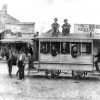calsfoundation@cals.org
Philip Pennywit [Steamboat]
The Philip Pennywit was a sidewheel paddleboat named for an esteemed Arkansas riverboat captain, plying a route between New Orleans, Louisiana, and Fort Gibson in the Indian Territory (modern-day Oklahoma).
Philip Pennywit had established the first regular service on the Arkansas River in the early 1880s, expanding into the White River, where his Waverly steamboat was the first to ascend as far as Batesville (Independence County). By 1849, he had retired from the active river trade to become a merchant in Van Buren (Crawford County), though he remained involved in the steamboat business.
In 1849, Pennywit and Captain Robert Beatty, described as “an enterprising, accommodating and a safe boatman,” had a steamboat built in Cincinnati, Ohio, that would be named for the former riverboat captain. The Philip Pennywit was a 246-ton sidewheel steamer that was 180 feet long and thirty-three feet wide with a 6.3-foot draft. The vessel, which was finished out in Louisville, Kentucky, could carry 650 tons of freight.
After making its inaugural voyage to New Orleans in February 1849, the Philip Pennywit was advertised as making regular runs from there to Little Rock (Pulaski County), Van Buren, Fort Smith (Sebastian County), and Fort Gibson in Indian Territory (present-day Oklahoma), “touching at all the intermediate landings.” The steamboat would also ascend the Mississippi and Ohio rivers to service Louisville, Kentucky. By the fall of 1850, the Louisville Daily Courier was praising the vessel, writing, “The Pennywit has proved herself…to be the finest low water boat of her dimensions afloat.”
On April 27, 1851, the Pennywit, by then under the command of Captain Thomas A. Applegate, collided with the steamboat Tuscumbia on the Mississippi River shortly after leaving New Orleans, breaking the latter’s starboard engine, and “tearing away the wheel, blacksmith shop and store room.” The Philip Pennywit apparently sustained little or no damage, while the Tuscumbia returned to New Orleans for repairs.
On May 13, 1851, the Philip Pennywit suffered the fate of many nineteenth-century steamboats while descending from Fort Smith when it hit a snag in the Arkansas River, and sank immediately. It was deemed to be a total loss, although the vessel was fully insured. The Pennywit was partially salvaged, and in late May 1851 the steamer Trustee arrived in Louisville “with the machinery of the Philip Pennywit aboard.”
For additional information:
“Ark’s River Packet, Philip Pennywit.” (Advertisement), Weekly Arkansas Gazette, April 12, 1849, p. 1.
“Latest News.” [Louisville, Kentucky] Courier-Journal, May 7, 1851, p. 3.
“The River and Weather.” [Louisville, Kentucky] Daily Courier, May 27, 1851, p. 3.
“Steamboats.” New Orleans Crescent, February 14, 1849, p. 3.
“The Steamer ‘Philip Pennywit’,” Arkansas Intelligencer, March 3, 1849, p. 2.
[Louisville, Kentucky] Daily Courier, September 30, 1850, p. 3, col. 4.
Natchez [Mississippi] Daily Courier, June 3, 1851, p. 2, col. 3.
Way, Frederick, Jr. Way’s Packet Directory. Athens: Ohio University Press, 1983.
Mark K. Christ
Central Arkansas Library System







Comments
No comments on this entry yet.